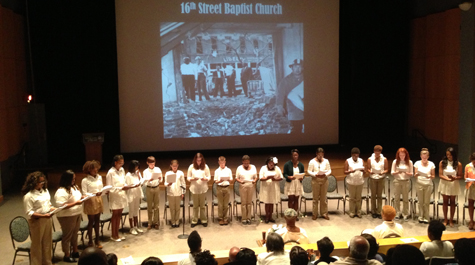Remembering the lives of 'four little girls'
W&M hosts staged reading on 50th anniversary of Birmingham church bombing
Four little girls. Four dreams. Four lives cut short.
Sunday marked the 50th anniversary of the racially motivated 16th Street Baptist Church bombing in Birmingham, Ala., that took the lives of Addie Mae Collins, 14; Cynthia Wesley, 14; Carole Robertson, 14; and Denise McNair, 11. William & Mary took part in a nationwide effort to commemorate those lives Sunday evening by hosting a staged reading of a play that portrayed not only four lives that were, but four that could have been.
Approximately 100 people attended the staged reading of “Four Little Girls: Birmingham 1963,” directed by theatre and Africana studies professor Artisia Green and held in the Sadler Center’s Commonwealth Auditorium. The event was hosted by the W&M Center for Student Diversity and IPAX and held simultaneously with other staged readings across the nation as part of an effort organized by Project1Voice. The reading was followed by a live viewing of a post-performance discussion held at The Kennedy Center in Washington, D.C.
Green welcomed the audience by telling them that she often teaches her students that theatre performances are akin to rituals, which are “generally performed for purposes of efficaciousness – participants are seeking a change in outcome.”
“By being here today, you are participating in this artistic ritual, and it is our hope that hearing the words of the playwright, Christina Ham, through the mouths of these children and young adults from Beauty for Ashes School of Contemporary Dance, Jamestown High School, York County School of the Arts and Hampton University that you will consider the ways in which you can work to further the dream of Dr. Martin Luther King,” said Green. “I will, with some hesitation, go as far as saying that perhaps we do not live in the extreme circumstances of the four young children we are honoring today, but with great certainty I will argue that we are not far from it.”
After a symbolic tribute of remembrance for the four girls involving the pouring of water onto earth, representatives from the National Pan-Hellenic Council, Black Student Organization, E.S.S.E.N.C.E. Women of Color, Kappa Alpha Psi and the William & Mary NAACP read a unity letter, reaffirming their commitment to “engage us all in the collective struggle for educational, economical, historical, and political viability,” said Green.
“We vow to embrace social progression and not aggression, to fight for equality on the battlefield of social injustice, and to find hope when the world seems hopeless,” said representatives from the W&M NAACP.
Twenty people – mostly youth -- participated in the staged reading, including students from local schools, a W&M alumna and her child. Wearing simple, white shirts or dresses and khaki pants, the readers used their voices to recreate the lives of the four girls in the week leading up to the bombing. They were lives restricted by segregation and threatened by violence in a city that was nicknamed “Bombingham,” but they were lives still full of the concerns and hopes of young girls. Just weeks after Martin Luther King Jr. delivered his famous “I have a dream” speech, the girls had dreams of their own: becoming a doctor, teacher, professor, baseball player.
The lights went dark in the Sadler Center to represent the moment in which those dreams were cut short when a bomb planted by Klu Klux Klan members in the church basement exploded, killing the four girls, injuring 22 and destroying the back wall of the church and all of its stained windows -- except one that showed Jesus leading a group of children to heaven.
Slides projected on the wall behind the readers told the audience what happened next. The FBI stopped investigating the bombing after J. Edgar Hoover asserted that it was members of the civil rights movement who had done the bombing themselves. A witness identified Robert Chambliss as one of the men who planted the bomb, but he received only a $100 fine and a six-month jail sentence. In 1971, the case was reopened, and, in 1977, Chambliss was tried again, this time receiving a sentence of life in prison. He died eight years later. In 2000, the FBI fingered three other men along with Chambliss for the bombing: Herman Cash, Thomas Blanton and Bobby Cherry. Cash was already dead, but the two others were tried and convicted.
At the end of Sunday night’s event, the audience stood together and sang as a final slide showed a new stained glass window that now hangs in the 16th Street church, depicting Jesus with arms outstretched. The words at his feet are from a verse in the Gospel of Matthew that reads, “Truly I say to you, inasmuch as you have done it to one of the least of these my brothers, you have done it to me.”
 Skip to main content
Skip to main content

